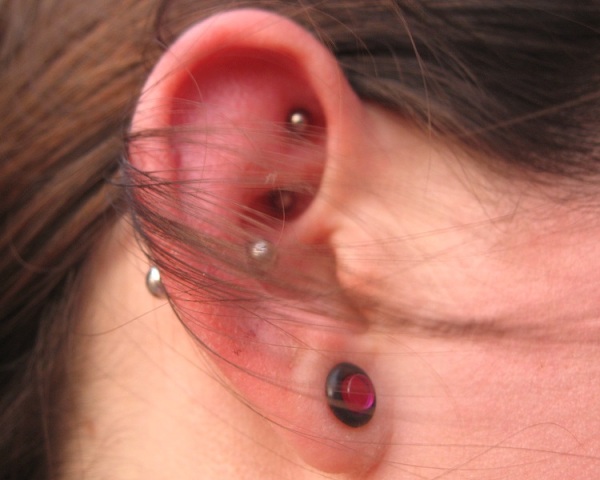Everyone around you is too stuck on the ear lobe piercing, go crazy with rook piercing! Read on to know more about rook piercing.
Rook Piercing
Ear piercings have been around for a while now; Julius Caesar wore gold rings in his ears about 5000 years ago, gods and goddesses in Hindu mythology have adorned earrings for the longest time. In the present times, ear piercings are one of the simplest risk free fashion statements and they invariably look good on everyone unlike a whacky purple colored Mohawk or the tattoo of a dragon on your back. People these days have transcended from the boring old ear lobes and moved on to other parts of the ear. The current hot favorite among the individualistic souls craving for a new look is the rook piercing. Rook is an area just above the ear canal. It is located in the region termed as the anti-helix. It is one of the most painful piercings and can take up to 2-12 months to heal. The anti helix region contains thick cartilage hence this piercing is quite a challenge even for the piercer. Close to ten percent of rook piercings get rejected, which is a comparatively large number when compared to other kinds of piercing. Maintenance is a must when it comes to rook piercings. Here are some precautions that are essential to avoid rejection of the piercing.

Image: nicoleversetwo@flickr
Rook Piercing Care
-
The most important step that needs to be taken before getting a rook piercing done is to do research on the piercing studio. Make sure you have spoken to people who have gotten their rooks pierced. Go to a piercing studio that is recommended by someone who has already experienced rook piercing in the same studio.
-
It is a difficult piercing and the skill of the piercer in question is something that needs to be taken into account. It can go horribly wrong, and be extremely painful if the piercer is not skilled.
-
Take a friend or a parent along for moral support, you will have to give in certain documents for age proof and even sign a couple of mandatory documents. However, in India there exist no such pre-requisites. Once inside the studio, look around; make sure the place is clean. Insist on a new needle and make sure that the needle is sterilized. Ensure that the piercer wears gloves. Clear all your queries and doubts before the piercer starts the procedure.
-
This kind of piercing is called cartilage piercing and is considerably more painful. In this kind of piercing, the piercer punctures the cartilage from one side and takes it out from the other side using scissors. Once the hole is made, the jewelry you have chosen is inserted in.
-
The best rook piercing jewelry is made of titanium. Surgical steel is also widely recommended. Make sure that the jewelry you select is not of poor quality as this region is highly susceptible to infections.
-
Once the piercing is done, clean the piercing every day in the shower. Use disinfectant solution in a cotton swap and apply it around the jewelry 2-3 times in a day.
-
Saline solution also helps increase the healing time, therefore use that regularly. Do not keep the region of the piercing damp all the time as it can lead to infections
-
Do not use creams and do not keep touching the piercing constantly.
-
In case of increase in swelling or redness or some kind of green/yellow pus discharge consult your piercer and the local physician immediately. These are all symptoms of infection, and require immediate medical care.
-
If you have long hair keep your hair tied, as especially in rook piercing the chances of the hair getting entangled with the jewelry is high and can lead to infections.
See also
More from iloveindia.com
- Home Remedies | Ayurveda | Vastu | Yoga | Feng Shui | Tattoos | Fitness | Garden | Nutrition | Parenting | Bikes | Cars | Baby Care | Indian Weddings | Festivals | Party ideas | Horoscope 2015 | Pets | Finance | Figures of Speech | Hotels in India : Delhi | Hyderabad | Chennai | Mumbai | Kolkata | Bangalore | Ahmedabad | Jaipur
- Contact Us Careers Disclaimer Privacy Policy Advertise With Us Lifestyle Sitemap Copyright iloveindia.com. All Rights Reserved.







